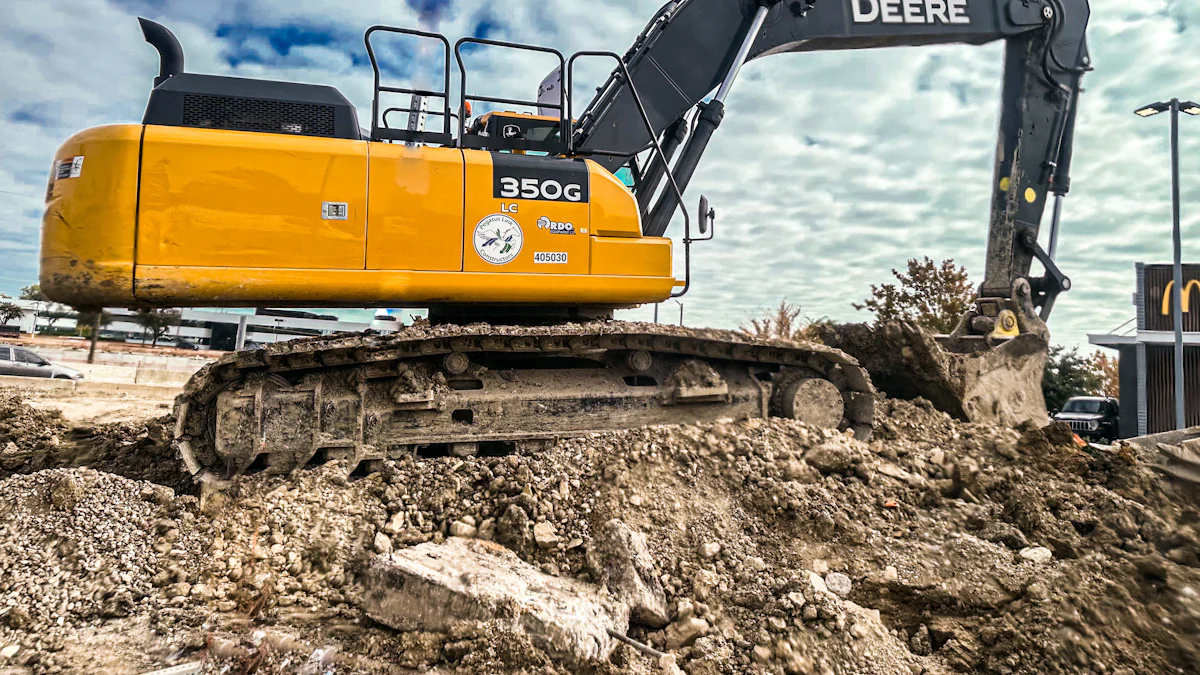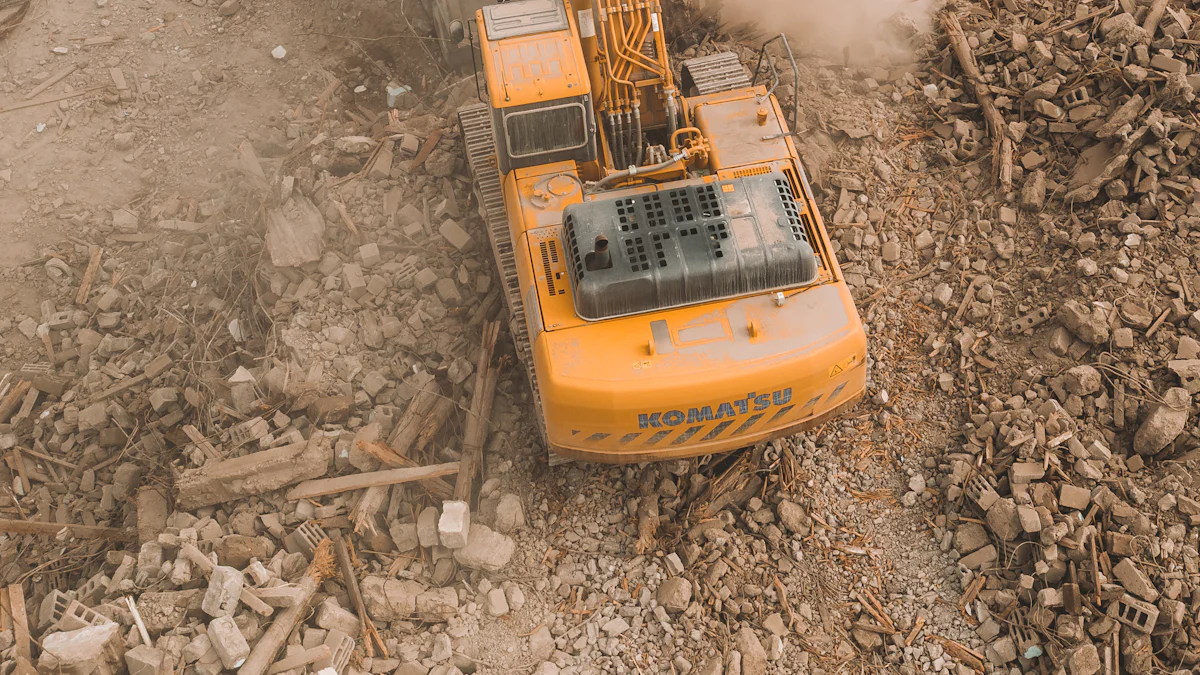
Replacing the rubber tracks on your excavator with rubber tracks may feel overwhelming at first. However, with the right tools and a clear plan, you can handle this task efficiently. The process requires attention to detail and proper safety measures to ensure success. By following a structured approach, you can replace the tracks without unnecessary complications. This not only keeps your machine in top condition but also ensures smooth operation during your projects.
Key Takeaways
- 1.Preparation is crucial: Gather essential tools like wrenches, pry bars, and a grease gun, and ensure you have safety gear to protect yourself during the process.
- 2.Safety first: Always park the excavator on a flat surface, engage the parking brake, and use wheel chocks to prevent movement while working.
- 3.Follow a structured approach: Carefully lift the excavator using the boom and blade, and secure it with a jack to create a stable working environment.
- 4.Loosen the track tension properly: Remove the grease fitting to release grease and make it easier to detach the old track without damaging components.
- 5.Align and secure the new track: Start by placing the new track over the sprocket, ensuring it is aligned with the rollers before tightening the tension gradually.
- 6.Test the installation: After replacing the track, move the excavator forward and backward to check for proper alignment and tension, making adjustments as necessary.
- 7.Regular maintenance extends lifespan: Inspect tracks regularly for wear and damage, and follow manufacturer guidelines to ensure optimal performance.
Preparation: Tools and Safety Measures
Before you begin replacing the rubber tracks on your mini excavator, preparation is key. Gathering the right tools and following essential safety measures will make the process smoother and safer. This section outlines the tools you’ll need and the precautions you should take to ensure a successful track replacement.
Tools You’ll Need
Having the proper tools on hand is crucial for this task. Below is a list of essential tools you’ll need to complete the job efficiently:
-
Wrenches and socket set
You’ll need a variety of wrenches and sockets to loosen and tighten bolts during the process. A 21mm socket is often required for the grease fitting. -
Pry bar or track removal tool
A sturdy pry bar or a specialized track removal tool will help you dislodge the old track and position the new one. -
Grease gun
Use a grease gun to adjust the track tension. This tool is vital for loosening and tightening the tracks properly. -
Safety gloves and goggles
Protect your hands and eyes from grease, debris, and sharp edges by wearing durable gloves and goggles. -
Jack or lifting equipment
A jack or other lifting equipment will help you raise the excavator off the ground, making it easier to remove and install the mini excavator rubber track.
Safety Precautions
Safety should always come first when working with heavy machinery. Follow these precautions to minimize risks and ensure a safe working environment:
-
Ensure the excavator is on a flat, stable surface
Position the machine on level ground to prevent it from shifting or tipping during the process. -
Turn off the engine and engage the parking brake
Shut off the engine completely and engage the parking brake to keep the excavator stationary while you work. -
Use wheel chocks to prevent movement
Place wheel chocks behind the tracks to add an extra layer of stability and prevent any unintended movement. -
Wear appropriate safety gear
Always wear gloves, goggles, and sturdy footwear to protect yourself from potential injuries.
Pro Tip: Double-check all safety measures before starting the replacement process. A few extra minutes spent on preparation can save you from accidents or costly mistakes.
By gathering the necessary tools and adhering to these safety precautions, you’ll set yourself up for a smooth and efficient track replacement. Proper preparation ensures that the job is not only easier but also safer for you and your equipment.
Initial Setup: Parking and Lifting the Excavator
Before you begin removing the used excavator tracks, you need to properly position and lift your mini excavator. This step ensures stability and safety throughout the replacement process. Follow these instructions carefully to prepare your machine for the task.
Positioning the Excavator
Park the excavator on a flat, level surface
Choose a stable and even surface to park your excavator. Uneven ground can cause the machine to shift or tip, increasing the risk of accidents. A flat surface provides the stability needed for safe lifting and track replacement.
Lower the boom and bucket to stabilize the machine
Lower the boom and bucket until they rest firmly on the ground. This action helps anchor the excavator and prevents unnecessary movement. The added stability will make lifting the machine safer and more efficient.
Pro Tip: Double-check that the parking brake is engaged before proceeding. This small step adds an extra layer of security.
Lifting the Excavator
Use the boom and blade to lift the excavator rubber tracks off the ground
Activate the boom and blade to lift the excavator slightly off the ground. Raise the machine just enough to ensure the tracks are no longer in contact with the surface. Avoid lifting it too high, as this could compromise stability.
Secure the machine with a jack or lifting equipment before proceeding
Once the excavator is lifted, place a jack or other lifting equipment under the machine to hold it securely in place. Ensure the jack is positioned correctly to support the weight of the excavator. This step prevents the machine from shifting or falling while you work on the tracks.
Safety Reminder: Never rely solely on the boom and blade to keep the excavator lifted. Always use proper lifting equipment to secure the machine.
By carefully positioning and lifting your excavator, you create a safe and stable environment for replacing the tracks. Proper setup reduces risks and ensures the process goes smoothly.
Removing the Old Track

Removing the old track from your excavator with rubber tracks requires precision and the right approach. Follow these steps to ensure a smooth and efficient process.
Loosening Track Tension
Locate the grease fitting on the track tensioner (typically 21mm)
Begin by identifying the grease fitting on the track tensioner. This fitting is usually 21mm in size and is located near the undercarriage of the excavator. It plays a crucial role in adjusting the track tension. Take a moment to inspect the area and confirm its position before proceeding.
Remove the grease fitting to release grease and loosen the track
Use the appropriate wrench or socket to remove the grease fitting. Once removed, grease will start to release from the tensioner. This action reduces the tension in the track, making it easier to remove. Allow enough grease to escape until the track becomes loose. Be cautious during this step to avoid any sudden release of pressure.
Pro Tip: Keep a container or rag handy to collect the grease and prevent it from spilling onto the ground. Proper cleanup ensures a safer and more organized workspace.
Detaching the Track
Dislodge one end of the track using a pry bar
With the track tension loosened, use a sturdy pry bar to dislodge one end of the track. Start at the sprocket end, as this is typically the easiest point to access. Apply steady pressure to lift the track off the sprocket teeth. Work carefully to avoid damaging the sprocket or the track itself.
Slide the track off the sprockets and rollers, then set it aside
Once one end of the track is free, begin sliding it off the sprockets and rollers. Use your hands or the pry bar to guide the track as it comes off. Move slowly and methodically to prevent the track from getting stuck or causing injury. After removing the track completely, place it in a safe location away from your workspace.
Safety Reminder: Tracks can be heavy and cumbersome to handle. If needed, ask for assistance or use lifting equipment to avoid strain or injury.
By following these steps, you can successfully remove the old track from your rubber tracks for mini excavator. Proper technique and attention to detail will make the process more manageable and prepare you for installing the new track.
Installing the New Track

Once you have removed the old track, it’s time to install the new one. This step requires precision and patience to ensure the track fits securely and functions properly. Follow these instructions to align and secure the new track on your excavator with rubber tracks.
Aligning the New Track
Place the new track over the sprocket end first
Start by positioning the new track at the sprocket end of the excavator. Lift the track carefully and place it over the sprocket teeth. Ensure the track sits evenly on the sprocket to avoid misalignment during the installation process.
Slide the track under the machine and align it with the rollers
After placing the track on the sprocket, guide it under the machine. Use your hands or a pry bar to adjust the track as needed. Align the track with the rollers on the undercarriage. Check that the track is straight and properly positioned along the rollers before moving to the next step.
Pro Tip: Take your time during alignment. A well-aligned track ensures smoother operation and reduces wear on the machine.
Securing the Track
Use a pry bar to lift the track onto the sprockets
With the track aligned, use a pry bar to lift it onto the sprockets. Start at one end and work your way around, ensuring the track fits snugly over the sprocket teeth. Apply steady pressure with the pry bar to avoid damaging the track or sprockets.
Gradually tighten the track tension using a grease gun
Once the rubber digger track is in place, use a grease gun to adjust the tension. Add grease to the track tensioner slowly, checking the tension as you go. Refer to the manufacturer’s specifications for the correct tension level. Proper tension ensures the track stays secure and operates efficiently.
Safety Reminder: Avoid over-tightening the track. Excessive tension can strain the components and reduce the lifespan of your excavator with rubber tracks.
By following these steps, you can successfully install the new track on your excavator. Proper alignment and tensioning are crucial for optimal performance and durability. Take your time to ensure the track is secure and ready for use.
Post time: Jan-06-2025
